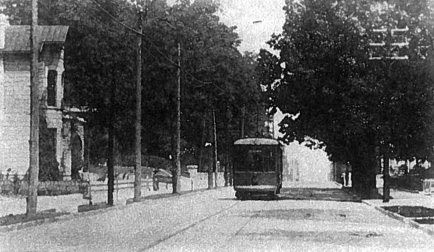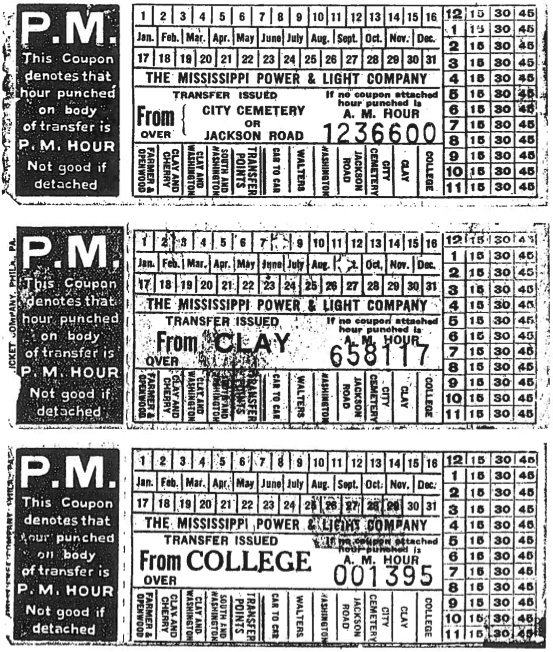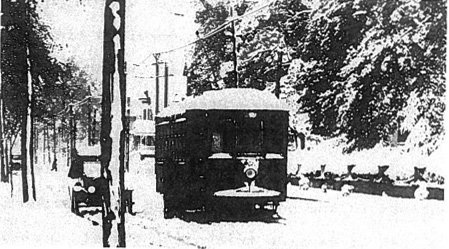Today’s post is Chapter 11 in our series re-printing Frank Brooks’ “Travelling by Trolley in Mississippi: Stories about Streetcars,” originally published in 1983. View other posts in the series at the “Streetcars” tab.
—————————————-
My mother was from a large Vicksburg family, and for that reason, relatives’ tales of the trolleys were standard and frequent. As a child, my mother rode the streetcar to school and back each day, and my uncle soaped the tracks on the hill passing the Bijou Theater many a summer night! Their grandmother and aunts told me about the changeover from mule power to electricity. One of my great great grandfathers even met his death on Washington Street after alighting from a streetcar and stepping into the path of an automobile!
During the 1940s, Vicksburg’s streets were still filled with abandoned trolley tracks peeking through their light asphalt covering; those tracks fascinated me no end. Although I lived 100 miles away, I was a frquent visitor to my great grandmother, my uncle, several great aunts and uncles, and cousins. Because I was in Vicksburg often, I knew the streets where the tracks remained in place. From downtown, we usually pulled our way up the South Street hill between Washington and Cherry Streets as we walked to my great grandmother’s house. The tracks in these blocks were in full view and looked entirely usable to me. From time to time, we enjoyed outings in the park at the end of Drummond Street, and I loved a set of passing tracks out there! Occasionally we went to the graves of relatives at City Cemetery and there remained much evidence of the car line which ran out that way to Walters. I always arrived at and departed from the Illinois Central’s Cherry Street station and the carbarn across the Cherry Street viaduct from the old train shed continued in use as a garage facility for busses during those years. Everything relating to the former streetcar system fascinated me, and I wanted to know as much about it as possible. I made it my business to ask many questions and I received many answers.
During late December of 1948 I bought a copy of the January, 1949 issue of Railroad Magazine from the newsstand in Meridian’s Union Terminal while waiting to return home after having the braces on my teeth adjusted. Upon boarding the panting train, I was thrilled beyond words when I opened the magazine and discovered an article about a run-away trolley in Vicksburg many years earlier. The story described a calm Sunday morning between 11:00 and 12:00 when a streetcar started down one of Vicksburg’s breathtaking hills at a snail’s pace. I’ve always thought it must have been the Clay Street hill. Quite suddenly, the trolley began picking up speed and the motorman quickly realized that his car was out of control! Using all the strength he could muster, he worked frantically with his handbrake to slow the car, but with no success. Then he frantically turned his controller in reverse, but the current was off and that brought no results. As the speed increased, the front end of the car began to rock and sway, and after another try or two to slow the trolley with the controller, the motorman yelled for all passengers to jump. Within a matter of seconds everyone had left the car. The trolley, unattended, gained speed for four more blocks and then left the rails and careened into another street. the wild streetcar crashed through a thick brick wall into a saloon with the head end of the car coming to rest with its drawbar stick hard and fast into a barrel of fine southern whiskey! Since the car was empty when it struck the building, the only person who lost his life was an unfortunate old man who had been walking down the sidewalk. However, most of the passengers collected plenty of scrapes and bruises from their jump onto the brick street. It was said that every preacher in the city capitalized on that exciting event the next Sunday as their sermons emphasized the fact that nobody would have been hurt in the first place had they been present for the worship services in their churches instead of being out riding on a city streetcar!
The original company, the Vicksburg Electric Street Railway, opened its first line of eight miles amidst much festivity on April 24, 1899. There was abundant celebrating for a whole week in connection with this event. Not only was the electric streetcar line inaugurated, but a new opera house was opened, and one full day was devoted to decorating the graves of the Confederate dead. However, the streetcar inaugural was, by far, the most prominent event. During the April 21 opening day the trolleys gave free rides to Ken-Caryl Park, where a gigantic barbeque was enjoyed by several thousand persons. The streets were elaborately decorated with flags and bunting, and many bands from both Vicksburg and neighboring towns kept the air filled all day with rousing music. Among the bands, the one from the U.S.S. Nashville occupied the place of special honor.
Several very large arches were constructed over selected streets to give an extra special dimension to the celebration related to the beginning of electric trolley service in Vicksburg. While all the arches were handsome, the ones constructed by the city of Vicksburg, the Illinois Central Railroad, and the Vicksburg Electric Street Railway were noted as being the most attractive. The streetcar company’s arch was crowned with one of the old mule-drawn cars which, until then, had rattled and banged through the city!
Through a series of successive companies, Vicksburg’s electric transit system finally emerged as the Vicksburg Light and Traction Company in 1912. At its peak, the company operated 22 cars on 11.5 miles of track. In 1923, the V.L.&T. Co. came under the control of the Mississippi Power and Light Company, which operated the streetcars until 1939, when they were displaced by the busses of the Vicksburg City Lines, Inc. I was four years old at the time and therefore just missed being able to remember anything at all about the system on a first-hand basis.
————————————————-
ABOUT THE AUTHOR: Frank A. Brooks, Jr. has loved trains and streetcars for as long as he can remember. He and his wife Jo Anne are parents of 2 children and grandparents of 4. During his active ministry of 43 years in the Presbyterian Church he served in Kentucky, Mississippi, Virginia and Arkansas. In retirement, Dr. and Mrs. Brooks live in her hometown Corinth, MS.
Categories: Architectural Research, Vicksburg








I wanted to let you know that the Historical Society of Gulfport will meet this evening at 6 p.m. at the Gulfport Fire Deprtment. Paul Jermyn will make presentation on the constuction of port and the G and SI Railroad.
LikeLike
Sorry I missed it! It sounds like an interesting talk. If you send me those kinds of talks beforehand, I can put them on the MissPres calendar.
LikeLike
What remains of the Vicksburg Trolley system can be seen here:
http://martykittrellphotos.blogspot.com/2009/06/vicksburg-trolley.html
LikeLike
Thanks for reminding us of your post, Marty! I had forgotten those pictures, but they’re a great addendum to this post.
LikeLike
Dear Marty Kittrell
One more thing about the Vicksburg Street Cars.
I am told the original Trolly Repair Shops and Electrical plant continues to exist.
The Location is adjacent to the Rail road at the Corner of Pine and Monroe Street.
Catty – Cornered and across the intersefccton behind Fisher’s Funeral Home.
The Rough looking concrete building with the new brick front on the east side,
It will be remembered by our older citizens as the automobile Bus Barn but before the Buses it was the trolly barn.
Please take and post pictgures.
Sam P
LikeLike
I am not a Camera Person. We do need several Photos of the Old Street Car – Auto Bus Barn at the South West Corner of Monroe and South Streets in Vicksburg, THe old rough building is quite historic.
Could some one please take and post the Photos. Sam P
LikeLike
Error – The Location is at the South West corner of Monroe and Pine Streets, Catty – Cornered Across the intersection from Fisher’s Funeral Home. I repeat, I made an error in the recent post, Sam P
LikeLike
The Vicksburg Evening Post, Thursday, March 29th, 1979; The Old Post Files – 90 Years Ago;
“W A Stanton, is making plans for a pavillion in Ken Caryl Park to be erected by the Street Rail Road Company
And of course, the Street Rail Road Company was the Trolley Company.
LikeLike
It is August 31, 2018
I have just walked thru an old trolley marked “Washington” on one end and “Clay” on the other. The original bifold doors (2 pairs on opposing sides) are in tact. It has served as a camphouse for many decades but is in remarkable condition. Thought y’all would be happy to know that one of these still exists.
Dale Jennings & Tully Hall
LikeLiked by 1 person
Greetings! This streetcar was part of a fishing camp owned by my family for many years. I’ve gotten word in a roundabout way via Chick Warner that y’all have purchased it and are interested in any pictures we might have to show it’s original condition. Unfortunately the only picture that I can scrounge up shows the color that I remember best: rust! My folks sold the camp in the 1980s, but while I was growing up it was very much a part of my life. I’ve been putting out feelers to anyone who might remember more about its original colors. I’m glad to know that the opposite end to “Clay” is “Washington.” That end was usually behind a cistern. I don’t know what is left of the old camp nowadays, but the metal stairs at either end were rescued from old buildings. The back stairs were from the old Speed Street school. I forget where the front stairs came from.
LikeLike
According to the US Census Bureau compilation for 1902, the Vicksburg streetcar system had 8.5 miles of line and carried 1,188,289 passengers.
At 1907, the system had 10.0 miles of line and carried 1,679,600 passengers.
Thereafter (1912, 1917, 1922, 1927, 1932), it was grouped together with “the rest” of Mississippi’s streetcar systems in the Census Bureau surveys. My “best guesses” for annual passenger traffic thereafter:
1912: very roughly 2 million.
1917: very roughly 1.7 million.
1922: very roughly 1.6 million.
1927: very roughly 1.5 million. System length was down to 8.2 miles by that year.
1932: very roughly 600,000.
As for the year of closure, other sources say 1935, but I’ll stick with Dr. Brooks’ recollection of 1939 (although that does sound a bit late).
LikeLike
A “Vicksburg Post” article states that the decision on whether to replace streetcars with buses was submitted to voters on July 12, 1932. The vote in favor of buses was 724 to 80. The city adopted an ordinance during the following month that permitted Mississippi Power and Light to replace the streetcars with buses. However, the change did not take place until the system was sold to Vicksburg City Lines.
See:
“VICKSBURG FACTS: The transition from streetcars to buses in Vicksburg,” by Vera Ann Fedell, published July 15, 2022.
LikeLike
My attempts to pin down the “last day” of streetcar operation have led to a Jackson newspaper article that states . . . August 14, 1932.
That’s a few years earlier than the previously reported years (1935, 1939), but it does sound reasonable, based on the newspaper story above.
The Jackson “Clarion-Ledger” ran a story, “Motorman Makes Last Trip Today” (Sunday, August 14, 1932, ·Page 15). This states that a veteran Vicksburg street car motorman, “Uncle Jerry” Jones, would “pilot the last street car in Vicksburg” on “Sunday morning.”
(Jones was described as the stepfather of a Jackson resident, C.T. Dillon.)
LikeLike